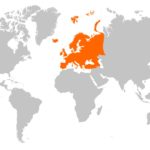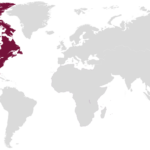Online shopping in Germany is bigger than ever, with millions of people turning to e-commerce for everything from groceries to fashion and electronics. As consumer habits evolve, some platforms dominate the market. They attract massive traffic month after month. If you understand which websites lead the way, you will be able to spot trends, analyze competition, and refine their online strategies.
From global giants to local powerhouses, today we will show you the most visited retail websites in Germany. They reveal what shoppers prioritize – price, convenience, or product variety.
This list, based on Semrush data, breaks down the top players shaping Germany’s e-commerce landscape in 2025. Let’s check it out!
Germany’s e-commerce boom: Why top retail websites matter in 2025
Have you ever wondered how online shopping has transformed the way Germans shop? In 2025, e-commerce in Germany is booming, with revenues expected to hit $107.85 billion. That’s a significant chunk of the retail pie, and it’s only getting bigger
So, why is this surge in online shopping so important for businesses? Let’s dive in.
A growing online community
By 2025, about 66.44% of Germany’s population will be active online shoppers. That’s over half the country clicking “add to cart.” This growing user base means a larger audience for e-commerce businesses to reach. More shoppers lead to more sales opportunities.
Rising revenues and opportunities
The e-commerce market isn’t just growing in users; it’s also swelling in revenue. With a compound annual growth rate (CAGR) of 7.13% from 2025 to 2029, businesses have a ripe opportunity to tap into this expanding market. Whether you’re a startup or an established retailer, there’s room to grow.
Mobile shopping: the new norm
Mobile commerce is taking off. As of January 2025, mobile devices account for 63.67% of total internet traffic in Germany. People love the convenience of shopping on their phones. For businesses, optimizing websites for mobile use isn’t optional – it’s essential. A mobile-friendly site can significantly boost sales and customer engagement.
Social media’s shopping influence
Social media platforms are becoming shopping hubs. With 65.5 million active social media users in Germany as of January 2025, businesses are leveraging these platforms for social commerce. It’s a trend that’s blending social interaction with shopping, offering a new avenue for sales.
Sustainability: a selling point
German consumers are increasingly eco-conscious. In 2025, 34% of consumers consider sustainability a primary factor in purchasing decisions. Businesses that adopt green practices contribute positively to the environment and attract a growing segment of mindful shoppers.
All the above-mentioned statistics come from our guide, Top 100+ Statistics about E-commerce in Germany. Check it out, it really contains more than 100 statistics about e-commerce in this country.
The list of 20 most visited retail websites in Germany 2025
The following ranking is based on Semrush data, showing the most visited retail websites in Germany in February 2025.
Let’s check it out!
Amazon.de
Visits: 413.53M
Origin country: United States
Amazon.de is, without a doubt, the e-commerce giant in Germany. With over 413 million visits, it dominates the market, pulling in more traffic than any other retail website. Why is it so popular? A massive product range, same-day delivery, and the trust it has built over the years. Germans love efficiency, and Amazon delivers, literally.
Another key factor? Amazon Prime. People are willing to pay for faster shipping, exclusive deals, and even access to Prime Video. The marketplace is also a big deal for third-party sellers, especially smaller businesses looking to reach a broad audience. Despite its dominance, competition is growing. Still, it’s hard to beat Amazon when it comes to convenience.
eBay.de
Visits: 106.12M
Origin country: United States
Ebay.de remains Germany’s go-to marketplace for second-hand items, collectibles, and auctions. With over 106 million visits, it’s still a powerhouse, but there’s a shift happening. Traffic has declined, meaning shoppers might be looking elsewhere. But why do people still use eBay?
For one, unique finds. Whether it’s vintage sneakers, rare books, or refurbished tech, eBay has it. Plus, it’s a strong platform for small businesses and independent sellers who don’t want to deal with Amazon’s strict rules. The auction model is another big draw—there’s always a chance to score a great deal.
Idealo.de
Visits: 69.14M
Origin country: Germany
Idealo.de is Germany’s top price comparison website. With 69 million visits, it’s clear that people in Germany love finding the best deals before they buy. Why pay more when you don’t have to? But Idealo doesn’t just compare prices – it gives detailed product insights, price trends, and even shipping costs. Whether it’s electronics, fashion, or household items, shoppers can see which retailer has the best offer.
Another reason for its success? Transparency. Germans value fair pricing and trust platforms that give them unbiased information. Retailers, in turn, benefit by reaching a massive audience actively looking to buy. And the mobile-first approach is paying off – mobile traffic is growing, meaning more people are comparing prices on the go.
Otto.de
Visits: 40M
Origin country: Germany
Otto is Germany’s biggest local e-commerce player, competing with Amazon on home turf. It’s a strong alternative, especially in categories like fashion, furniture, and electronics. But Otto has a more curated approach. It focuses on quality over quantity, working with well-known brands and ensuring a smoother shopping experience. People trust Otto for big purchases like sofas, home decor, and high-end fashion.
However, Otto is facing challenges. While its brand loyalty is strong, younger shoppers tend to prefer marketplaces with faster delivery and wider product choices. To stay competitive, Otto is investing in better logistics and digital services.
Chefkoch.de
Visits: 33.54M
Origin country: Germany
A surprise entry in the retail ranking? Not really. Chefkoch.de isn’t just a recipe site – it’s a food-focused e-commerce hub. With 33 million visits, it’s a go-to platform for meal ideas, but also for kitchen gadgets, specialty ingredients, and meal kits.
Why is it so popular? People love to cook, and Chefkoch makes it easy. Users can browse thousands of recipes, check reviews, and instantly buy the ingredients online. It’s the perfect mix of content and commerce. Chefkoch also has an engaged community. People trust recommendations from fellow home cooks.
Aliexpress.com
Visits: 30.07M
Origin country: China
AliExpress has carved out its space in the German market. The biggest draw? Low prices. AliExpress connects German shoppers with direct-from-China suppliers, cutting out middlemen and offering deep discounts. Whether it’s electronics, fashion, or quirky gadgets, you can find almost anything at a fraction of the price.
However, there’s a catch – shipping times can be long. Germans value efficiency, and waiting a month for a product isn’t ideal. To address this, AliExpress has been expanding its local warehouses, speeding up delivery times and competing more directly with Western marketplaces.
Mediamarkt.de
Visits: 28.97M
Origin country: Germany
Mediamarkt.de is Germany’s top electronics retailer. It’s the first stop for TVs, laptops, smartphones, and home appliances.
Why do people choose Mediamarkt over Amazon? Trust and expertise. Unlike pure online marketplaces, Mediamarkt combines its website with a strong offline presence. Customers can check products in-store and still order online for convenience. The biggest challenge is price competition. While Mediamarkt is known for quality and service, pure online retailers often offer better deals. To counter this, the company has been improving its online store, offering faster delivery and exclusive digital discounts.
Etsy.com
Visits: 26.84M
Origin country: United States
Etsy has carved out a solid niche in Germany’s e-commerce space, drawing 26 million visits from shoppers looking for unique, handmade, and vintage items. It’s the perfect place for those who want something a little different – whether it’s personalized jewelry, handcrafted furniture, or custom artwork.
What makes Etsy stand out? It’s all about the small businesses. Unlike Amazon, where mass-produced goods dominate, Etsy is home to independent creators and artists. People love supporting local and international artisans, knowing they’re buying something that isn’t factory-made. But Etsy faces challenges too. Shipping times and costs can sometimes be higher than standard e-commerce platforms, especially for international purchases.
Ikea.com
Visits: 24.99M
Origin country: Sweden
IKEA isn’t just a store – it’s an experience. It proves that Germans love the convenience of ordering furniture online. No need to wander through endless showrooms – you can browse, customize, and buy straight from your couch.
IKEA combines affordability with design. Whether it’s a minimalist desk, a cozy sofa, or smart storage solutions, it keeps things functional, stylish, and budget-friendly. Plus, the website offers detailed assembly guides and 3D planning tools, making home improvement easier. One of IKEA’s biggest advantages is its click-and-collect service. Many shoppers order online and pick up in-store, saving time and avoiding long delivery waits.
Amzn.to
Visits: 22.81M
Origin country: United States
Amzn.to might not seem familiar, but it’s a major part of Amazon’s ecosystem. It’s a link-shortening service Amazon uses for affiliate marketing. Bloggers, influencers, and reviewers use Amzn.to links to drive sales, earning commissions through Amazon’s affiliate program. People click these links knowing they’ll land on Amazon, where they feel comfortable making purchases. It’s especially big in tech, fashion, and home goods, where product recommendations influence buying decisions.
The more influencers and content creators promote products, the more Amazon benefits. It’s a clever way to drive sales without direct advertising.
Kaufland.de
Visits: 21.23M
Origin country: Germany
Kaufland.de is one of Germany’s fastest-growing online supermarkets and marketplaces. What started as a traditional grocery chain has turned into a major e-commerce platform.
Kaufland offers more than just food. While grocery delivery is a big part of its business, the site also sells electronics, clothing, home goods, and even garden supplies. It’s positioning itself as a one-stop shop, similar to Amazon but with a strong focus on local suppliers and fresh products. With the rise of online grocery shopping, Kaufland is investing heavily in faster delivery and better logistics. More people are skipping the supermarket trip, preferring to have essentials delivered straight to their door.
Lidl.de
Visits: 21.02M
Origin country: Germany
Lidl is making serious moves online, too. Its e-commerce site is thriving, especially in discount groceries and household essentials. And why are people shopping on Lidl.de? Great prices, limited-time offers, and easy home delivery. Lidl’s online store features exclusive deals you won’t always find in-store, from electronics to kitchen gadgets and even fashion. And unlike Amazon, Lidl has physical stores all over Germany, making click-and-collect a convenient option.
One of Lidl’s strengths is its strong brand reputation. Germans trust Lidl for quality at affordable prices, and that loyalty translates into online shopping.
Rewe.de
Visits: 19.74M
Origin country: Germany
Rewe is at the forefront of online grocery shopping in Germany, bringing in 19 million visits from people who prefer to order food and essentials from home. It’s one of the biggest names in supermarket e-commerce, challenging traditional ways of shopping.
No one enjoys crowded supermarkets, long checkout lines, or carrying heavy bags. Rewe’s online platform lets you order groceries and have them delivered – or pick them up at a local store. Rewe is also known for its fresh food quality. The competition with Lidl and Kaufland is heating up, but Rewe has an edge in fast local delivery.
Samsung.com
Visits: 19.4M
Origin country: South Korea
Samsung is one of the few brand-owned e-commerce sites to make the list, with so many visits from German shoppers looking for smartphones, TVs, and appliances. While people often buy Samsung products through retailers, many choose to shop directly from the source. Why? Exclusive deals and customization. Samsung’s website offers things you won’t find elsewhere – trade-in programs, early access to new devices, and direct discounts. Tech enthusiasts like to pre-order the latest gadgets, knowing they’ll get special offers and warranty benefits.
Another reason for Samsung’s strong traffic? Customer support and repair services. Buying from the official site ensures authentic products, easy returns, and access to Samsung’s repair network.
Zalando.de
Visits: 18.87M
Origin country: Germany
Zalando is Germany’s biggest online fashion retailer, attracting shoppers looking for clothing, shoes, and accessories. While Amazon sells everything, Zalando is laser-focused on fashion, and that’s what keeps it strong.
Why do people love it? Easy returns, massive selection, and strong brand partnerships. Zalando’s free 100-day return policy gives shoppers confidence – if something doesn’t fit, they can send it back without hassle. Plus, it stocks both high-end brands and affordable fast fashion, catering to every budget. Zalando Plus is one of its smartest moves. This premium service offers faster shipping and exclusive deals, locking in loyal customers.
To stay ahead, Zalando is investing in personalized recommendations and AI-powered styling tools.
Dm.de
Visits: 14.9M
Origin country: Germany
Dm is Germany’s most popular drugstore chain, and now it’s making waves online too. It has been a household name for decades, known for high-quality products at great prices. Its e-commerce site makes it even easier to stock up on skincare, baby products, vitamins, and organic foods – without a trip to the store. Sustainability is another key factor. Dm has a strong eco-friendly product range, which appeals to conscious consumers.
While Rossmann and Müller are its biggest competitors, Dm is leading the pack by offering more digital features, like in-app shopping and subscription-based product deliveries.
Payback.de
Visits: 13.95M
Origin country: Germany
Payback isn’t your typical online retailer—it’s Germany’s largest loyalty rewards program, bringing in 13 million visits from people eager to collect and redeem points. It is so successful because it’s connected to almost every major retailer. Whether you shop at Rewe, DM, or even Booking.com, you can rack up points and exchange them for discounts, gift cards, or cashback offers. For regular shoppers, it’s basically free money.
The real strength of Payback is its app and digital integrations. People can track their points, activate special offers, and use digital coupons – all from their phones.
Obi.de
Visits: 11.88M
Origin country: Germany
Obi is Germany’s leading DIY and home improvement retailer, bringing visits from people tackling renovation projects, garden makeovers, and home upgrades. If you need tools, flooring, or outdoor furniture, Obi.de is one of the first places you’ll check.
Not everyone wants to roam a warehouse-sized store looking for supplies. Obi’s website lets customers compare products, check stock availability, and order straight to their doorstep. Plus, click-and-collect is a lifesaver for those who need materials fast.
Obi is also stepping up its game with how-to guides and project planning tools. Whether you’re installing a kitchen backsplash or building a deck, the site offers advice alongside the products you need.
Hornbach.de
Visits: 10.61M
Origin country: Germany
Hornbach is another heavyweight in the DIY sector. What sets it apart? Big projects, big materials, and big savings. While Obi and Bauhaus focus more on everyday home fixes, Hornbach caters to serious builders. If you need construction materials, outdoor structures, or industrial-grade tools, this is the place to go. The website is designed for detailed product comparisons, making it easy to find exactly what you need.
One of Hornbach’s biggest selling points? Its price matches guarantee. If you find a better deal somewhere else, they’ll match it. The brand is also investing in e-learning content, helping customers gain the confidence to take on bigger projects themselves.
Bauhaus.info
Visits: 10.49M
Origin country: Germany
Bauhaus rounds out the top DIY retailers. It’s similar to Obi and Hornbach but has a slightly different strategy – focusing on both professional builders and everyday homeowners. What makes Bauhaus stand out is its massive product range. Whether you need plumbing supplies, solar panels, or home decor, Bauhaus has it. And just like its competitors, it’s investing in online tools, detailed guides, and fast delivery options.
Another big advantage? Bauhaus’ international presence. It really has expanded across Europe, giving it an edge in supply chain logistics.
Bonus: Trends shaping German e-commerce in 2025
Several key trends are influencing how businesses operate and how consumers shop online.
Dominance of online marketplaces
German consumers increasingly favor online marketplaces over individual brand stores. Platforms like Amazon.de and eBay.de offer a vast array of products, competitive pricing, and reliable delivery services, making them the preferred choice for many shoppers.
Mobile commerce on the rise
Mobile devices have become central to the online shopping experience in Germany. With mobile commerce accounting for a significant portion of e-commerce sales, retailers are optimizing their websites and apps for mobile users.
Integration of advanced technologies
Innovations such as AI, AR and VR are transforming the e-commerce sector. These technologies offer individualized shopping experiences, virtual try-ons, and interactive product visualizations, helping consumers make informed decisions and reducing return rates.
Growth of social commerce
Social media platforms are evolving into shopping destinations. With so many active social media users in Germany, retailers are leveraging these platforms for social commerce, blending social interaction with seamless shopping experiences.
Omnichannel strategies
Consumers expect a seamless shopping experience across online and offline channels. Retailers adopt omnichannel strategies, integrate their online stores with physical outlets, offer services like click-and-collect, and ensure consistent customer service across platforms.
Secure and diverse payment options
German shoppers prefer secure and familiar payment methods. The rise of Buy Now, Pay Later (BNPL) options and local payment solutions cater to these preferences, making the checkout process smoother and boosting conversion rates.
Focus on customer reviews and user-generated content
Consumers heavily rely on reviews and user-generated content to make purchasing decisions. Retailers are encouraging satisfied customers to leave positive reviews and share their experiences, building trust and influencing potential buyers.
Last words
Most visited retail websites in Germany are leading in traffic, provide insights into consumer preferences, and tell us more about their behavior. Knowing such websites helps businesses understand where shoppers are spending their time and money online. So yes, this knowledge is fundamental for developing strategies to attract and retain customers.
Now we can see that the e-commerce landscape in Germany is vibrant and full of opportunities. Stay informed about trends and consumer behaviors, and you will position yourself for success in this dynamic market.
***




